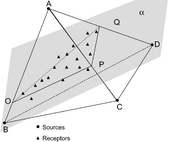A two step procedure that combines an air dispersion model with a receptor model was used to identify the key sources that contribute to air levels of suspended particulate matter. The contribution to PM10 concentrations measured at four monitoring sites in San Nicolás, Argentina, of the following sources, a thermal power plant, an integrated steel mill, motor vehicle exhaust fumes, and finally dust from paved and unpaved roads, have been analysed. Moreover, an air dispersion model was used to estimate the contribution of the thermal power plant, emissions of which have been described in depth by means of hourly fuel consumption and specific emission factors. The ratio “apportionment coefficient” was introduced to relate the contribution of this source to the measured 24 h PM10 concentrations by analysing the frequency of occurrence of connecting winds between the power plant and each monitoring site. In San Nicolás 70% of the PM10 sampled at three of the four monitoring sites could be attributed to the power plant in those scenarios where winds connected the facility’s tall point sources with the sampling locations. The contribution to the measured PM10 levels of the rest of the sources that are present in the analysed area was confirmed by way of receptor models. For this purpose, the multielemental composition of 41 samples was determined by Wavelength Dispersive X-ray Fluorescence analysis. In order to ascertain the underlying correlations between PM10 samples and potential sources, Principal Component Analysis was performed on the standard matrix of composition profiles, which comprises the measured PM10 samples being enlarged with the composition profiles of the potential contributing sources. The diagonalization of the covariance matrix was used as a screening procedure to differentiate the most likely contributing sources from those that were not significant.

You have access to this article
 Please wait while we load your content...
Something went wrong. Try again?
Please wait while we load your content...
Something went wrong. Try again?


 Please wait while we load your content...
Please wait while we load your content...